Distinguishing between the different types of black ants is not easy.
Many appear to be ants of the same species given their similar coloring. However, black ants come in different species with distinct physical particularities as follows.
Table of Contents
1. Eastern Black Carpenter Ant
The Eastern Black Carpenter Ant (Camponotus pennsylvanicus) is one of the largest black ants in the US. It’s found all around the country from mountainous regions to urban settlements.
The species is characterized by an all-black look. These ants have a black head and a black body. They are differentiated from other black ants by the white or yellow hairs on their abdomen.
Eastern Black Carpenter Ants are known to live in large nests. Up to a few thousand individuals of the species are known to live together in noisy nests.

The ants of a nest forage a large area of up to 100 yards around the nest. They look for food by leaving scent trails for other ants to follow.
As their name suggests, these ants are carpenter ants which means they seek to nest in pieces of decaying wood.
2. Black Harvester Ant
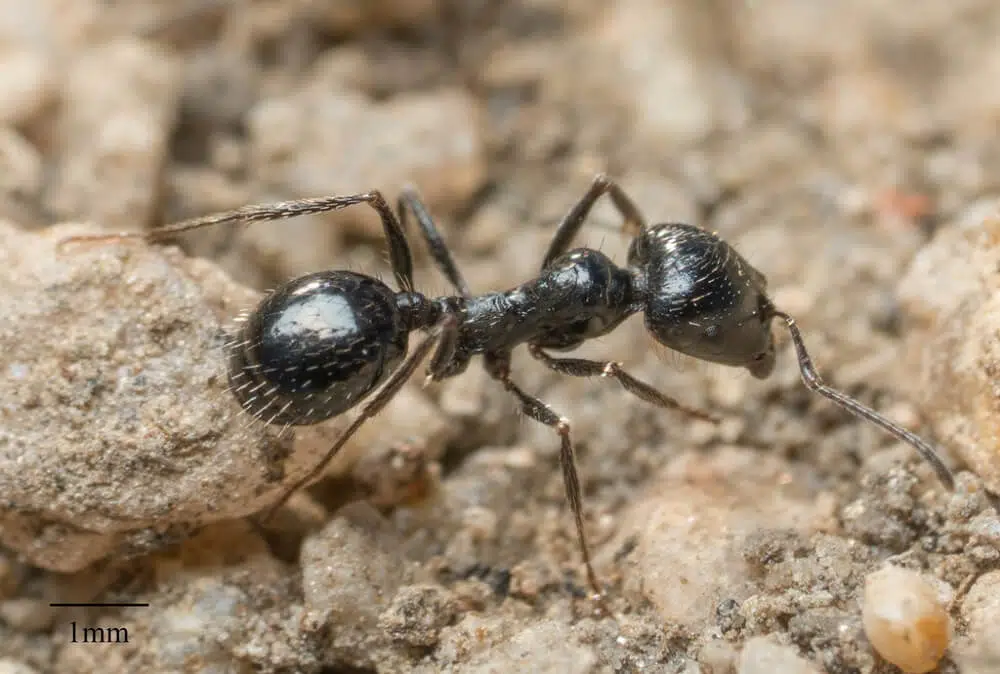
The Black Harvester Ant (Veromessor pergandei) is also known as the Desert harvester or the Black harvester.
Its natural habitat is in desert regions of California and other regions of Baja California.
The species can be identified by a black body with short white hairs on its thorax. Very large mandibles are also characteristics of the Black Harvester Ant.
Further identification is possible by comparing the size of these black ants. Males grow up to 8.5mm while females sometimes reach 10mm.
These black ants rely on their large mandibles to gather fruits and seeds for food. Common seeds these ants are interested in mostly include the seeds of perennial flowers.
3. Little Black Ant

Little Black Ants (Monomorium minimum) are some of the smallest black ants in the country. Worker ants measure 1-2mm while queen ants measure 4 – 5mm.
These ants live in multi-queen nests. They are highly common in Southern California as well as around the bay area around San Francisco.
Food preferences aren’t very specific for the species. Little Black Ants consume everything they find from moths to bird droppings.
Most people don’t see these ants during the day as they prefer to be nocturnal when moving long distances away from the nest.
Mating also happens during the night. These ants can fly and they mate while flying.
Male ants die shortly after mating while the remaining queen ants establish new nests where they lay eggs.
4. Western Carpenter Ant

Western Carpenter Ants (Camponotus modoc) are some of the most problematic pests in Western North America. These ants are recognized by their black bodies and red legs.
They grow to a size between 7 and 13mm as adults.
Western Carpenter Ants are known for their intrusive nature where they enter homes creating structural wood damages.
They build galleries in wood which eventually fully damages the wooden structure of a home.
Dealing with these ants can be complicated as the nest inside the house is never the only one around a home.
Western Carpenter Ants establish as many as 20 satellite nests around the main nest. This means a Western Carpenter Ant nest found inside the house can be doubled by multiple other nearby nests.
One of the best ways to avoid Western Carpenter Ant colonies inside or outside of the house is to clear and replace decaying wood from the structure of a home.
Western Carpenter Ants prefer to nest in decaying wood as it’s easier to build long and complex galleries through.
5. Silky Field Ant

These black ants (Formica subsericea) have a black body and black legs. Light gray markings are distinguished on the abdomen.
They grow to an average size between 4 and 8mm.
Silky Filed Ants are known to be very timid and they run away when encountering humans.
Found in the Eastern part of the US, these ants are known for nesting in the ground and being attracted by sweet foods rich in natural sugars such as fruits.
Silky Field ants are almost always confused with Formica fusca.
However, while similar in coloring, Formica fusca is larger than the Silky Field ant as it regularly grows up to 10mm.
Formic fusca is also known to feast on a large number of insects while Silky Field ants are mostly interested in sugary foods.
Silky Field ants are also known for their nuptial flight. This is a marking event in which ants fly and mate while flying at night.
6. Hairy Smooth Carpenter Ant
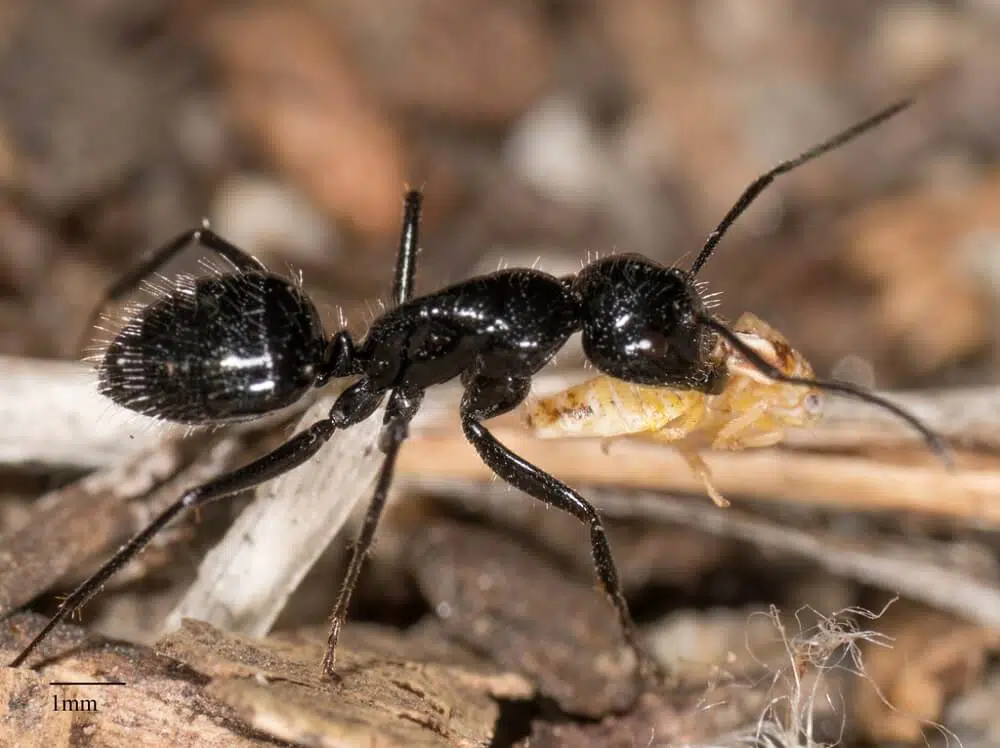
The Hairy Smooth Carpenter Ant (Camponotus laevissimus) gets its name from its short thin white hairs that cover its black body.
A black head, a black body, and black legs characterize this species best.
These ants can grow in a wide range of sizes which is one of the reasons they’re often confused with other species of black ants.
These ants grow to a body size of 7 to 13mm and can sometimes be known to be black with a blue tint.
Hairy Smooth Carpenter ants are diurnal and frequently seen around forests or pieces of redwood. They dig galleries in decaying wood and excavate all of the chewed wood outside.
These ants are also some of the most numerous per nest of all black ants. Some collected Hairy Smooth Carpenter Ants numbered more than 1.000 ants.
All Hair Smooth Carpenter ants feed on young moths. The species is known for showing the most interest in Western Spruce Budworms.
7. Hairy Panther Ant

The Hair Panther Ant (Neoponera villosa) is covered with red-brown hairs and has a black body and black legs. This is one of the black ants found in Texas that’s generally best to avoid.
Hairy Panther Ants always bite humans when handled. Avoiding stepping on their nests is the best method of staying away from these ants.
The highly aggressive nature of Hairy Panther Ants can also be seen in how they defend their nests.
These ants are known for killing and eating many types of insects. Large mandibles help them chew all sorts of insects at once.
Hairy Panther Ants are also known for having long stingers. These stingers are used to catch insects and inflict pain on other types of larger predators.
8. Immigrant Pavement Ant
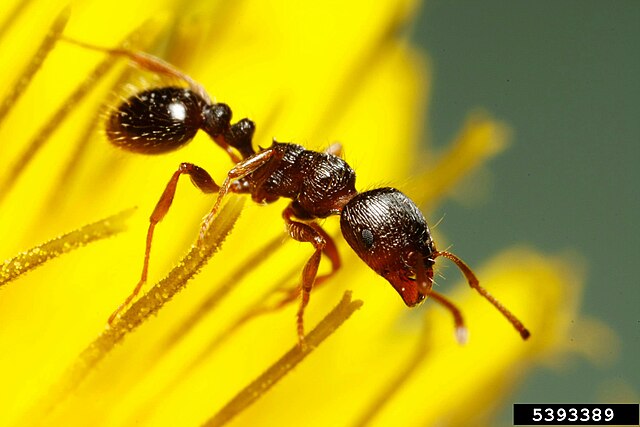
Most Immigrant Pavement Ants (Tetramorium immigrans) have a dark brown coloring that’s almost black. These ants are known for very high adaptability when it comes to nesting locations.
Since they don’t need a lot of vegetation to build a nest, Immigrant Pavement Ants are even seen on pavements, as their name suggests.
This species is known for living in urban areas as well as in forests. It’s also known to be an aggressive species.
Immigrant Pavement Ants can sting. However, their small stingers aren’t followed by too much pain when stinging humans.
These ants are also aggressive among each other. They often attack nearby Immigrant Ant colonies in long territorial battles.
These ants are all subject to working for a queen which leads the nest. The queen is first responsible for the nest and it feeds the first generation of workers until they become adults and can feed themselves.
Males have a primarily mating role. They always mate with queens first.
9. Odorous House Ant
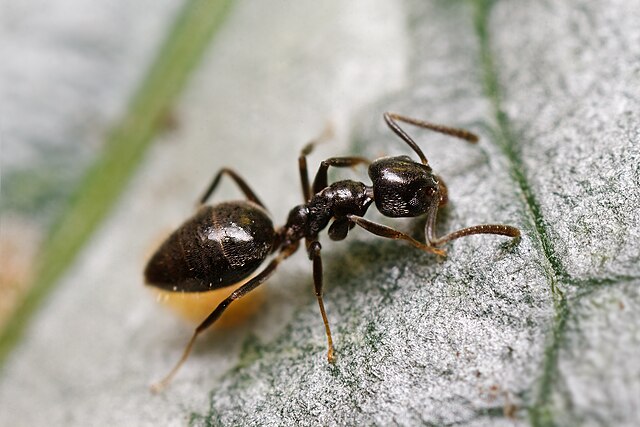
The Odorous House Ant (Tapinoma sessile) is native to North America. It can be found in most areas North of Mexico.
Odorous House Ants are known to live in very large nests. Some of these nests are the home of tens of thousands of ants.
Odorous House Ants can sometimes be black while they can be brown as well. These ants can grow to 3.2mm but this is rarely the case. High competition for food and honeydew prevents these ants from growing as large as they can.
Most Odorous House Ants grow just over 1.5mm. These ants are common around the house as pests.
However, removing them from homes isn’t complicated. A good anti ants spray is considered sufficient to kill both Odorous House Ants and their eggs.
Their egg takes up to 26 days to incubate which means they also need to be tackled when removing Odorous House Ants from a home.
10. Dark Rover Ant
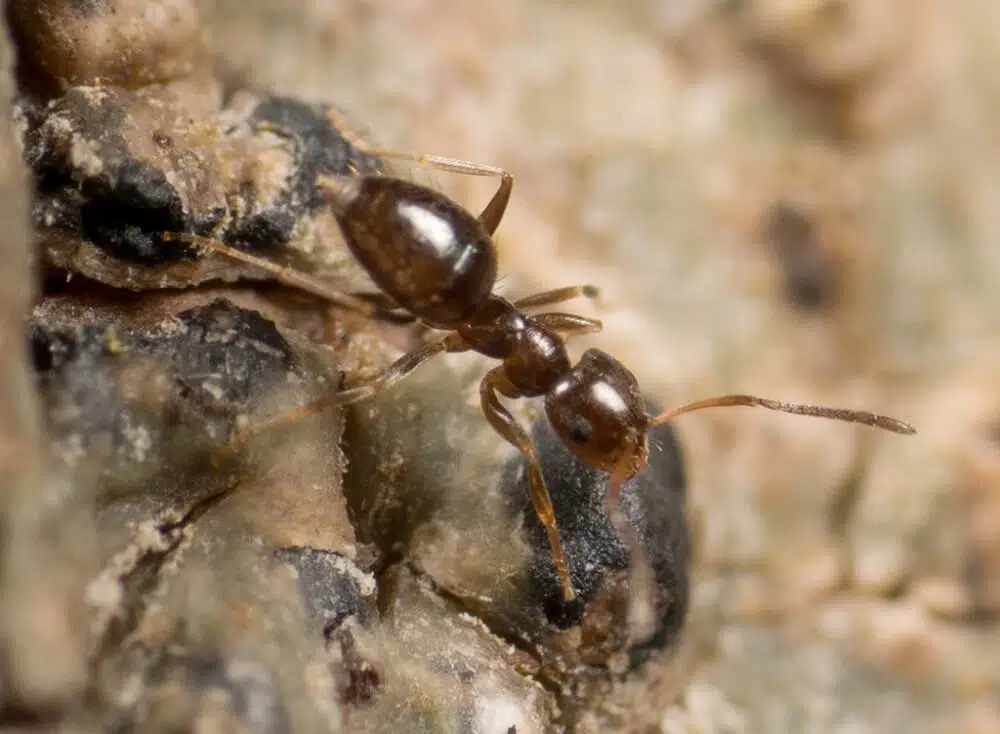
Dark Rover Ants (Brachymyrmex patagonicus) are native to South America. They made their way to Southern US where they are found in high numbers in Florida and California.
These ants are dark brown, almost black in the coloring of their bodies and their legs. They are known to form colonies in the ground.
Preferred habitat includes piles of leaves and rubbish piles where these ants can build their nests in.
However, Dark Rover Ants cannot create supercolonies as they are highly aggressive among them. They live in small colonies and always get aggressive towards other colonies.
These ants can make their way inside homes as they prefer to live next to man-made structures.
Dark Rover Ants can also be found in gardens. They prefer to nest under mulch which serves as a protective layer for their nest.
11. Asian Needle Ant
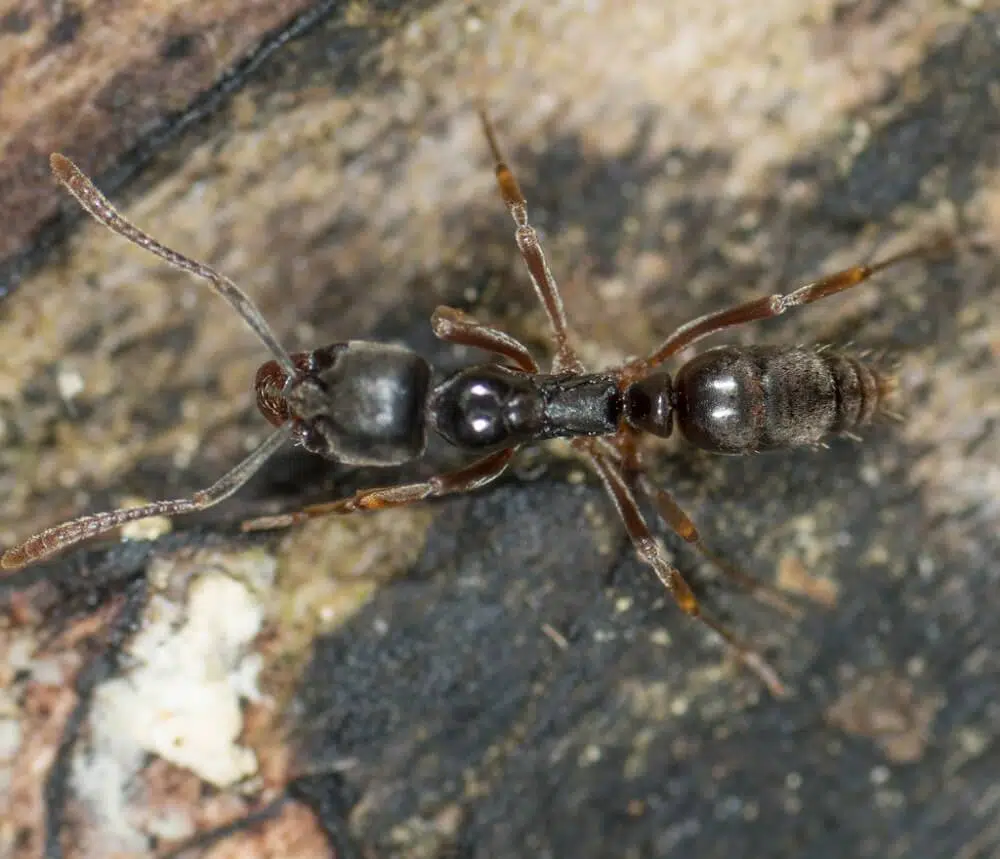
Asian Needle Ants (Brachyponera chinensis) are seen from May to August in Southeastern states such as Florida. They have been accidentally introduced in the US and around the world from South Africa.
These ants are of black-brown coloring and are considered household pests.
Asian Needle Ants are found in pine forests, mixed forests, and around the house as they’re adapted to urban environments.
The small ants primarily feed on honeydew from various insects. It’s believed these dark ants are also interested in other sweet foods.
12. Smaller Carpenter Ant

The Smaller Carpenter Ant (Camponotus nearcticus) grows up to 3.5 – 7.5mm and is found in the US, particularly in areas of Texas.
The species is known for having a bi-colored body. Its brown and black body makes for easy identification.
Smaller Carpenter Ants are routinely found around forests. Like carpenter ants, they can also make their way inside homes.
These ants are routinely found around rooftops, particularly around decaying wood rooftops.
Smaller Carpenter ants are known for building small nests. These aren’t black ants that live in their thousands together.
These ants routinely limit their nests to around 500 individuals.
13. Hairless Smooth Carpenter Ant
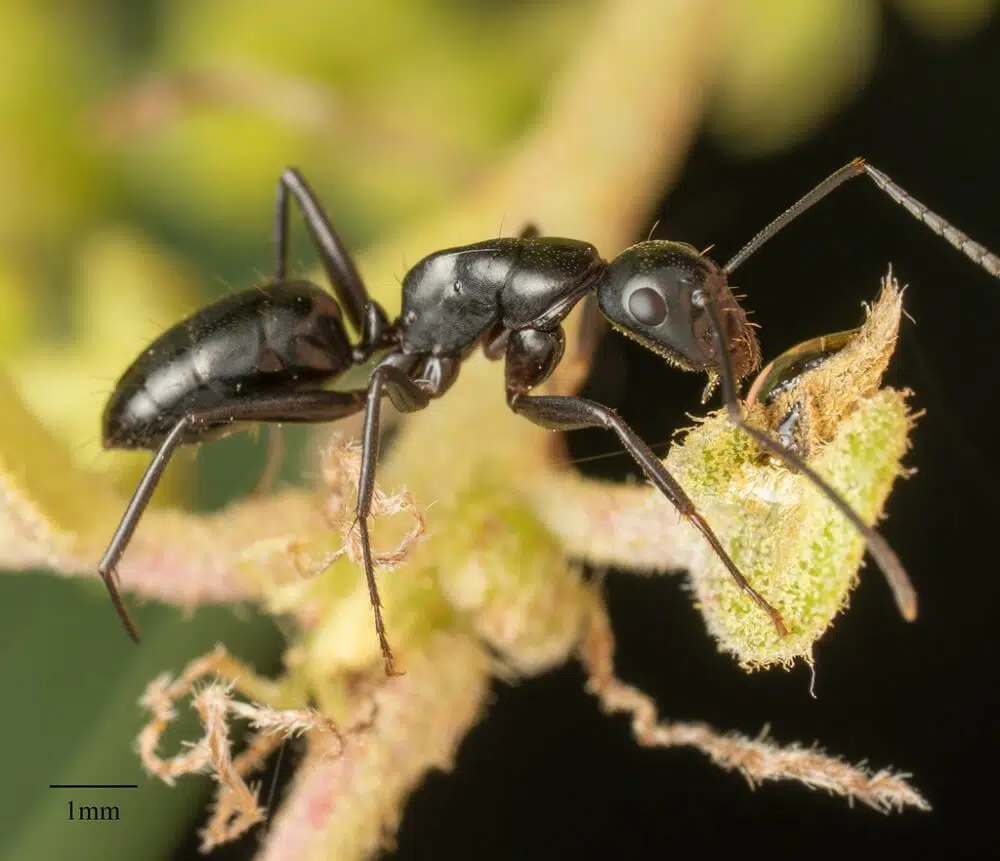
Hairless Smooth Carpenter Ants (Camponotus laevigatus) are found throughout the US. These ants are known for a shiny black body with shiny black legs. They also exhibit short white hair.
These ants are commonly associated with forests, particularly oak forests.
Early studies on the species indicate these ants cannot travel far from a forest as they need the decaying oak trees or branches to nest in.
However, not all types of decaying wood are used for nesting by the Hairless Smooth Carpenter Ant. It’s mostly the first stage of wood-decaying that these ants mostly prefer.
14. Small-lined Acrobat Ant

The Small-lined Acrobat Ant (Crematogaster lineolata) is recognized by its brown and black body with stripes. Ants of these species are common inside the house.
They tend to build indoor nests in areas that are difficult to reach to stay away from predators. Building nests behind walls is very common for the species.
Small in comparison to other black ants in the country, these ants show very aggressive behavior.
The ants bite humans if handled. Otherwise, they try to escape when seeing people but they are slower than most other ants.
15. Six-Spotted Carpenter Ant

The Six-Spotted Carpenter Ant (Camponotus sexguttatus) is native to South and Central America. It migrated to the US from Belize, Guatemala, and Honduras.
The species is recognized by its shiny black body. Its body also shows fine white horizontal lines, as with many other South-American-origin black ants.
Six-Spotted Carpenter Ants are very common in Florida. They are found in counties such as Brevard and Collier.
16. Florida Trap-jaw Ant

Active from May onwards, Florida Trap-jaw Ants (Odontomachus brunneus) are identified by their brown-black bodies. As their name suggests, these ants are common in Florida.
The ants live in sandy terrains as well as in woodlands and even swamp forests. Studies show this species is adapted to both dry and humid environments.
Ants of the species seek out rotten wood to nest. These ants are normally known to only nest in or around pieces of decaying wood in swamps but they can also nest in sandy terrains.
Florida Trap-jaw Ants aren’t aggressive and they don’t sting. Even when enemies approach their nests these ants don’t attack.
The species is known to flee in case of a nest attack. While other black ants get aggressive, the Florida Trap-jaw Ants leave the nest.
These nests are normally small. They can number anywhere between 11 and 177 worker ants.
17. Longhorn Crazy Ant
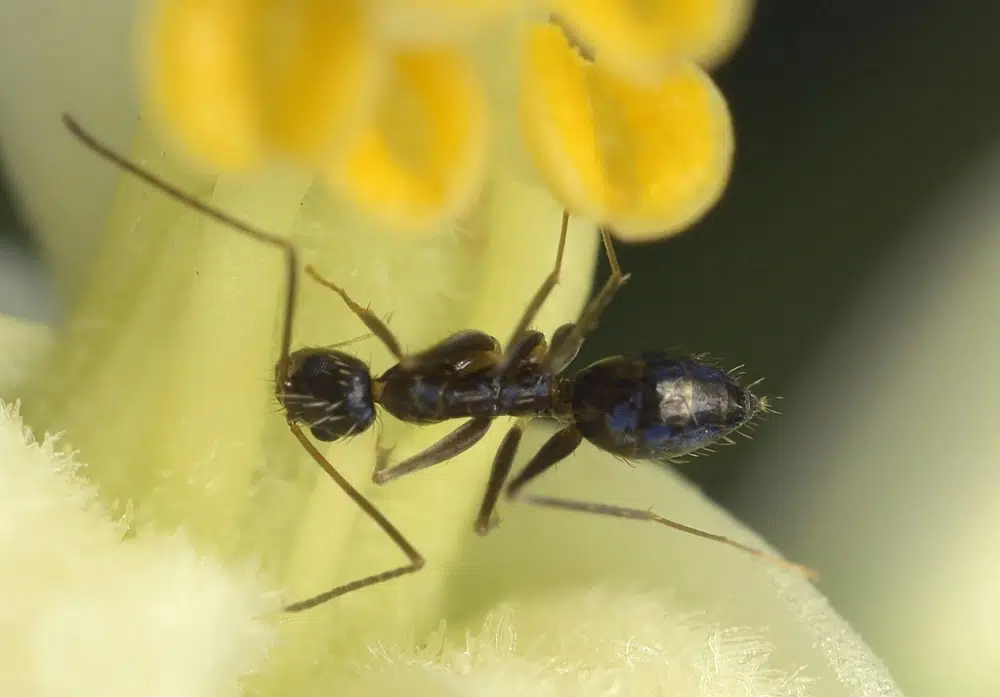
The Longhorn Crazy Ant (Paratrechina longicornis) gets its name from its directionless method of moving around. It moves more to the sides when it tries to progress further.
However, these are some of the most common black ants in the world. They live in tropical climates as well as temperate climates.
Longhorn Crazy Ants are considered household and agricultural pests.
You can recognize them inside of the house by their black body coloring with grey translucent legs.
These ants are rather small. They grow to a maximum of 2-3mm.
Ants of the species commonly mate among siblings without side effects. These ants make genetic clones.
The queen Longhorn Crazy Ants make genetic female clones as well as genetic male clones of the male mate.
18. Black Garden Ant

The Black Garden Ant (Lasius niger) is also known as the Common Black Ant. It lives in gardens across the US.
This species can be identified by an all-black glossy body. Males and worker ants grow anywhere between 3.5 and 4.5mm.
Queen Black Garden Ants grow to almost twice the size of male and female ants to around 9mm.
Multiple studies have been centered around the queen Black Garden Ant, mainly due to a very long lifespan.
Queen Black Garden Ants routinely live up to 15 years. The record-breaking queen ant has even been shown to live up to 29 years.
Queens establish nests themselves. These nests can be quite large to the extent of up to 40.000 individuals.
The process is complex. The queen sheds wings and digs in the ground where eggs are laid. The entrance to the nest is sealed.
Multiple queens are also very common in the largest Black Garden Ant colonies.
A few queens can work together to establish the first generation of workers. However, good communication between queens ends soon after the first generation of workers arises.
Queens can continue to live in the same nest with workers by separating themselves in certain areas of the nest.
Most commonly, Black Garden Ant queens fight each other for dominance once the first generation of worker ants appears.
The species is known for high adaptability for very large nests. These ants are capable of limiting communication with areas of the nest known for hosting different contagions.
Infected ants are practically isolated from healthy ants which maintains a quarantine level for sick ants while protecting the rest of the group.